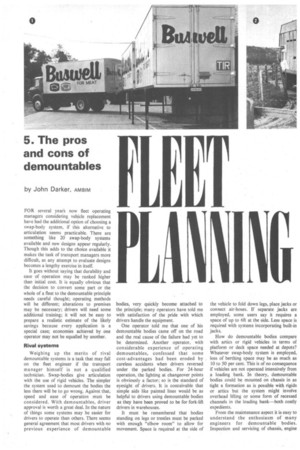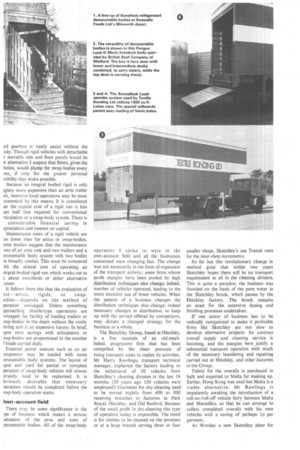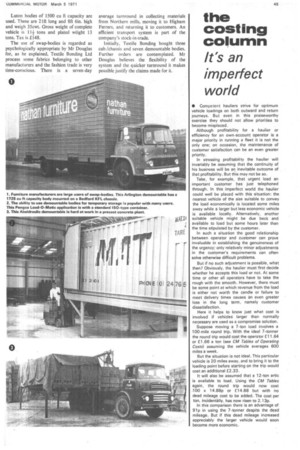tEE
Page 44

Page 45

Page 46

Page 47

If you've noticed an error in this article please click here to report it so we can fix it.
"Ii
5. The pros and cons of demountables
by John Darker, AMBIM
FOR several year now fleet operating managers considering vehicle replacement have had the additional option of choosing a swap-body system, if this alternative to articulation seems practicable. There are something like 20 swap-body systems available and new designs appear regularly. Though this adds to the choice available it makes the task of transport managers more difficult, as any attempt to evaluate designs becomes a lengthy exercise in itself.
It goes without saying that durability and ease of operation may be ranked higher than initial cost. It is equally obvious that the decision to convert some part or the whole of a fleet to the demountable principle needs careful thought; operating methods will be different; alterations to premises may be necessary; drivers will need some additional training; it will not be easy to prepare a realistic estimate of the likely savings because every application is a special case; economies achieved by one operator may not be equalled by another.
Rival eysterna Weighing up the merits of rival demountable systems is a task that may fall on the fleet engineer if the transport manager himself is not a qualified technician. Swap-bodies give articulation with the use of rigid vehicles. The simpler the system used to demount the bodies the less there will be to go wrong. Against that, speed and ease of operation must be considered. With demountables, driver approval is worth a great deal. In the nature of things some systems may be easier for drivers to operate than others. There seems general agreement that most drivers with no previous experience of demountable bodies, very quickly become attached to the principle; many operators have told me with satisfaction of the pride with which drivers handle the equipment.
One operator told me that one of his demountable bodies came off on the road and the real cause of the failure had yet to be determined. Another operator, with considerable experience Q f operating demountables, confessed that some cost-advantages had• been eroded by careless accidents when drivers reversed under the parked bodies. For 24-hour operation, the lighting at changeover points is obviously a factor; so is the standard of eyesight of drivers. It is conceivable that simple aids like painted lines would be as helpful to drivers using demountable bodies as they have been proved to be for fork-lift drivers in warehouses.
It must be remembered that bodies standing on legs or trestles must be parked with enough "elbow room" to allow for movement. Space is required at the side of the vehicle to fold down legs, place jacks or connect air-hoses. If separate jacks are employed, some users say it requires a space of up to 6ft at the side. Less space is required with systems incorporating built-in jacks.
How do demountable bodies compare with artics or rigid vehicles in terms of platform or deck space needed at depots? Whatever swap-body system is employed, loss of berthing space may be as much as 10 to 50 per cent. This is of no consequence if vehicles are not operated intensively from a loading bank. In theory, demountable bodies could be mounted on chassis in as tight a formation as is possible with rigids or artics but the system might involve overhead lifting or some form of recessed channels in the loading bank—both costly expedients.
From the maintenance aspect it is easy to understand the enthusiasm of many engineers for demountable bodies. Inspection and servicing of chassis, engine nd gearbox is vastly easier without the ody. Though rigid vehicles with detachable r movable side and floor panels would be n alternative I suspect that fitters, given the hoice, would plump for swap-bodies every me, if only for the greater personal mbility they make possible.
Because an integral bodied rigid is only ightly more expensive than an artic trailer nit, intensive local operations may be most :onomical by this means. It is considered iat the capital cost of a rigid van is less• ian half that required for conventional rticulation or a swap-body system. There is considerable financial saving • in spreciation and interest on capital.
Maintenance costs of a rigid vehicle are [so lower than for attics or swap-bodies. ome studies suggest that the maintenance )sts of, an artic unit and two trailers and a mountable body system with two bodies re broadly similar. This must be compared ith the annual cost of operating an itegral-bodied rigid van which works out to e about two-thirds or either alternative /stem.
It follows from this that the evaluation of
ast--artics, rigids, or swapodies--depends on the method of peration envisaged. Unless something pproaching shuttle-type operations are ivisaged the facility of loading trailers or vap-bodies in the depot without the costly riving unit is an expensive luxury. In brief, spot time savings with articulation or rap-bodies are proportional to the number I loads carried daily.
External power sources such as an air 3mpressor may be needed with some mountable body systems. The layout of spot and yard for partial or complete peration of swap-body vehicles will almost srtainly need to be replanned. It is bviously desirable that necessary terations should be completed before the yap-body operation starts.
Iwn —account field
There may be some significance in the Tie of business which makes a serious raluation of the pros and eons of smountable bodies. All of the swap-body operators I spoke to were in the own-account field and all the businesses concerned were changing fast. The change was not necessarily in the form of expansion of the transport activity; some firms whose profit margins have been eroded by high distribution techniques also change; indeed, number of vehicles operated, leading to the more intensive use of fewer vehicles. When the pattern of a business changes the distribution techniques also ,change; indeed necessary changes in distribution, to keep up with the service offered by competitors, may dictate a changed strategy for the business as a whole.
The Sketchley Group, based at Hinckley, is a fine example of an old-established, progressive firm that has been compelled by the sheer pressure of rising transport costs to replan its activities. Mr Harry Rawlings, transport technical manager, explained the factors leading to the withdrawal of 50 vehicles from Sketchley's cleaning division in the last 18 months. (20 years ago 150 vehicles were employed!) Garments for dry-cleaning used to be moved nightly from 400 to 500 receiving branches to factories at Park Royal, Hinckley, and Old Basford. Because of the small profit in dry-cleaning this type of operation today is impossible. The trend is for clothes to be cleaned on the premises or at a large branch serving three or four
smaller shops. Sketchley's use Transit vans for the inter-shop movements.
So far has this revolutionary change in method gone that within two years Sketchley hopes there will be no transport requirement at all in the cleaning division. This is quite a paradox; the business was founded on the basis of the pure water in the Sketchley brook, which passes by the Hinckley factory. The brook remains an asset for the extensive dyeing and finishing processes undertaken.
If one sector of business has to be radically reorganized to make it profitable firms like Sketchley are not slow to develop alternative projects. Its contract overall supply and cleaning service is booming, and the margins here justify a substantial transport operation with much of the necessary laundering and repairing carried out at Hinckley, and other factories the Group.
Fabric for the overalls is purchased in bulk and exported to Malta for making up. Earlier, Hong Kong was used but Malta is a viable alternative. Mr Rawlings is impatiently awaiting the introduction of a roll-on/roll-off vehicle ferry between Malta and Marseilles, so that he can arrange to collect completed overalls with his own vehicles with a saving of perhaps lp per garment.
At Worsley a new Sketchley plant for overall laundering has been designed around the swap-body concept. The Ronway equipment ordered was chosen by Mr Rawlings for its simplicity and robustness after extensive study of available equipment. He spent three days at the Commercial Motor Show in London "until I was sick of the sight of swap bodies" and much time subsequently in attending demonstrations of various swap-body systems. He confesses to being swayed to his ultimate choice of system by the knowledge that the Ronway equipment is used by a large quarry group. "If it will stand that-work it is good enough for me," commented Mr Rawlings.
Sketchley expects to need six chassis cabs and 11 bodies when the Warsley overall cleaning and distributionservice for the Manchester area is in full swing. The company may decide to make slight alterations to a factory at Hadleigh for swap-body operations. Plants at Walthamstow and at Hinckley could not be readily converted, though ' work-study people are looking at the problem.
Points in favour Reasons given by Mr Rawlings for the decision to adopt swap-body operations at Worsley are as follows: 1. To make best use of drivers' working day. If rigid vehicles were employed each driver would lose three hours a day loading or off-loading.
2. To save floor space in plant. Itis estimated that two-thirds of the area otherwise needed in goods received section is saved with use of swap-bodies.
3. Incoming bales of soiled overalls can be stored in swap-bodies until process plant can cope with volume; there areconsiderable time-economies in dispatch; garments will be packed in bodiesI9ft-long boxvans on Ford D600 chassis—as they are packed and labelled, awaiting the return of driver with bales of soiled protective clothing.
Mr R. A. Jolly, responsible for transport functions at Belling Ltd, Enfield, is a comparatively large user of swap-bodies. He operates 14 chassis cabs, each with two bodies. Belling does not warehouse its products at all—apart from temporary storage in the large capacity van bodies. All its products„ mainly electric cookers, are supplied direct to wholesalers, electricity boards, multiple stores, etc. Some deliveries involve as many as 30 drops, which gives point to the tail-lifts and rear shutters fitted.
After a satisfactory experiment with Pengco equipment in 1966 the company became enthusiastic about the savings with swap-bodies. Apart from marked savings in tyres as compared with attics each demountable saves £100 a year in licence fees; 1000 cu ft bodies are used—a size determined after a survey of customer premisei. Larger bodies of 30 or 4011 length would be practicable for deliveries from the Belling factory but too many deliveries would be impossible.
Design changes in Belling products occurred after the first batch of swap-bodies had been ordered and future bodies may be higher to cope more easily with the "space ship" controls on modern cookers. As it is, van loads of 80 cookers ride on top of each other with the Simplest of packing. Vitreous enamel finish on the cookers is very seldom damaged through shock or vibration in tran sit.
With a production at Enfield of around 950 cookers a day, all needing to be cleared from the factory immediately, the utility of the capacious swap-bodies. to be used for temporary storage is apparent. Mr Jolly is confident that the swap-body solution for a proportion of Belling deliveries is paying off: Freightliners are used for some long-distance deliveries, with conventional large attics for trunking operations between Belling factories at Enfield and Burnley.
Buswell Foods Ltd, of Northampton and Blisworth, formed last year by combining the assets of three old-established companies, is avowedly set on doubling its present DOI turnover. At Blisworth a modern abattoir converts beef and mutt( on the hoof to domestic-sized joints at prepared foods using the most efficie known means. It goes without sayit that rapid distribution services supermarket groups and high-cla catering, establishments is mandator Buswell serves the quality end the market in Britain and as far afield , Germany, and the enthusiasm of the you' executive board communicates itself to departments, not least the transpo department under Mr Lionel Murton.
• Refrigerated containers by Bonallack a employed with the Bonallack Loadspeed demountable body system. Delivery radii with the swap-bodies is around 70 miles. Ito Murton uses three trucks with flu containers. Two of the vehicles are Comm VC7 12-tonners, and the third a Comm plated at 16 tons.
The original plan was to operate tv trucks with four containers but as weight often a bigger factor than bulk with me deliveries the heavier vehicle is provii useful on some runs. A factor in Buswell use of swap-bodies was its reluctance employ Class 3 drivers on artics. Unloadil of meat is a semi-skilled operation an apart from that aspect, skilled attic 'drive would not be readily obtainable Blisworth. The 6am starting time drivers—the vans are pre-loaded—enabl drivers to be delivering in North London Birmingham at 8 am.
TI R operation Buswell's decided to order bodi approved for TIR operation initially meet any eventuality. Costing some I: extra—as contrasted with £150 for conversion—the overseas facility has n yet been used but it provides an insuranc currently live cattle are brought I contractors' vehicles from Birkenhead b there is the risk that changed slaughterh policies could compel the company collect meat slaughtered in Ireland, elsewhere.
Mi. Murton reckons to be able to wri off the purchase cost of Loadspeed equipment in three years. He points to tl considerable taxation savings and to ea; maintenance with swaP-bodis. His fea about driver-reaction were unfounded; tl Buswell drivers like to use the equipme and find no difficulty in its operation. yard man at Blisworth using a slave chass helps to speed up the turnround. Is difficulties have been experienced with tl battery-operated demountable syster though slave batteries are maintained fi occasional use.
Textile Bonding Ltd of Higham Ferrers another satisfied user of swap-bodi (Bonallack Loadspeeder system). Iv Spencer Douglas, group distributic manager, said that transport costs we excessive before swap-bodies we introduced at Textile Bonding's Burnley az High= Ferrers factories, but these lu been brought down well below budget figures for 1970. Despite the reduction drivers' hours there has been .a net saving one vehicle despite a greater throughp of traffic between the factories. Luton bodies of 1500 cu ft capacity are used. These are 21ft long and 8ft 6in, high and weigh 35cwt. Gross weight of complete vehicle is 114tons and plated weight 13 tons. Tax is £148.
The use of swap-bodies is regarded as psychologically appropriate by Mr Douglas for, as he explained, Textile Bonding Ltd process some fabrics belonging to other manufacturers and the fashion trade is very time-conscious. There is a seven-day average turnround in collecting materials from Northern mills, moving it to Higham Ferrers, and returning it to customers. An efficient transport system is part of the company's stock-in-trade.
Initially. Textile Bonding bought three cab /chassis and seven demountable bodies. Further orders are contemplated. Mr Douglas believes the flexibility of the system and the quicker turnround it makes possible justify the claims made for it.




































































































